Posts Tagged: Jeff Smith
Extreme weather accelerates nitrate pollution in groundwater
Extreme weather spurred by climate change, including droughts and heavy rains, may increase the risk of nitrates from fertilizers ending up in groundwater, according to a recent study from researchers at the University of California, Davis. The study found heavy rains after a drought caused nitrates to seep 33 feet under farm fields in as little as 10 days. The study was published in Water Resources Research.
“The conventional wisdom was that it could take several weeks to years for nitrates to move from the crop root zones to reach groundwater,” said corresponding author Isaya Kisekka, a professor in the Departments of Land, Air and Water Resources and Biological and Agricultural Engineering. “We found these extreme events, such as California's atmospheric rivers, are going to move nitrate more quickly.”
In this study, different methods were used to measure how much nitrate, a component of nitrogen fertilizer, was seeping down through the soil in a tomato and cucumber crop near Esparto, California. Scientists conducted their research from 2021 until 2023 when California was experiencing periods of drought followed by atmospheric rivers. They measured nitrate during both the growing seasons and the rainy seasons.
Drought can leave more nitrogen in soil
Previous studies have shown about 40% of nitrogen fertilizer used for vegetables isn't absorbed by the plants but remains in the soil. During droughts, crops don't use nitrogen efficiently, leading to excess nitrogen in the soil. This study found that if a drought is then followed by heavy rainfall, that sudden burst of water causes nitrate to seep in groundwater more quickly. The nitrate concentration in the shallow groundwater exceeded the U.S. Environmental Protection Agency maximum contaminant level of 10 milligrams per liter for drinking water.
“In California, we often say we swing between droughts and floods,” said Kisekka. “These extreme events that come with climate change are going to make the risk of these chemicals ending up in our drinking water much more severe.”
Groundwater is the primary source of drinking water for most of California's Central Valley. In some regions, such as the Tulare Lake Basin, nearly one-third of drinking and irrigation wells exceed the EPA's safe nitrate level. High nitrate levels in drinking water can increase health risks, especially for young children. It may also increase the risk of colorectal cancer.
Need for real-time soil nitrate monitoring
Central Valley farmers are required to report to the Regional Water Board how much nitrogen they applied to their field and how much was removed as part of the crop's yield. The study compared different ways of monitoring when nitrate from fertilizers seep into groundwater. Kisekka said the results highlight the need for affordable, real-time soil nitrate monitoring tools to help farmers manage fertilizer use efficiently.
By using conservation practices that limit leftover nitrates in the crop's root zone after harvest, farmers can help reduce nitrate contamination in groundwater.
This study's data will also help improve a model called SWAT, which is used to track nitrate seepage into groundwater across California's Central Valley. This effort is part of the Central Valley Water Board's program to regulate irrigated farmlands.
Other UC Davis authors include Iael Raij Hoffman, Thomas Harter and Helen Dahlke.
The study was supported by the USDA Natural Resource Conservation Service through its Conservation Effects Assessment Project. The national project is designed to assess the effectiveness of conservation practices across different watersheds. The study also had support from the USDA National Institute of Food and Agriculture.
Curator Jeff Smith: Spreading the Wings of Butterflies
Do you know how to spread the wings of a butterfly specimen? It's not as easy as it looks, but entomologist Jeff Smith, curator of the Bohart Museum of Entomology's Lepidoptera collection, makes it look easy. If you attend the Bohart Museum...
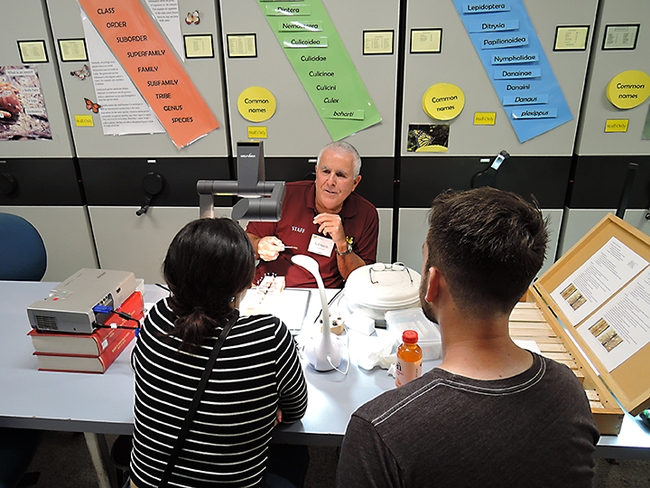
Entomologist Jeff Smith, curator of the Bohart Museum's Lepidoptera collections, shows visitors how to spread the wings of a butterfly. (Photo by Kathy Keatley Garvey)
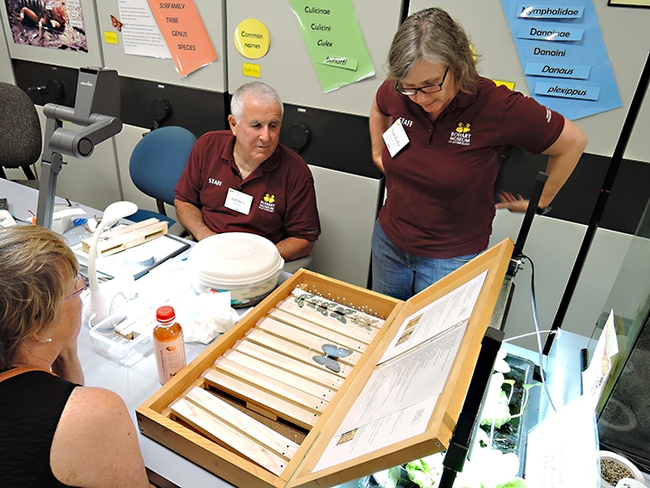
Jeff Smith, curator of the Bohart Museum of Entomology's Lepidoptera collection, discusses projects with UC Davis doctoral alumna Fran Keller, professor at Folsom Lake College, a UC Davis lecturer, and a Bohart research associate/affiliate. (Photo by Kathy Keatley Garvey)
Know Your ABC's: Arthropods, Bohart and Collecting
Folks are looking forward to the next open house at the Bohart Museum of Entomology at UC Davis. It's set Saturday, Sept. 28 from 1 to 4 p.m. and the theme is "Museum ABC's: Arthopods, Bohart and Collecting." It's free and family friendly....

Entomologist Jeff Smith, curator of the Lepidoptera collection at the Bohart Museum of Entomology, with a drawer of monarch specimens. (Photo by Kathy Keatley Garvey)

A closeup of a male monarch on a Mexican sunflower, Tithonia rotundifola, in a Vacaville garden. (Photo by Kathy Keatley Garvey)

A closeup of a female monarch on lavender in a Vacaville garden. (Photo by Kathy Keatley Garvey)
Moths and Butterflies: What Are the Differences?
What are the differences between moths and butterflies? That was a key question asked at the Bohart Museum of Entomology's annual Moth Night, held both indoors and outdoors on the UC Davis campus on Saturday, July 20. Doctoral student Iris...
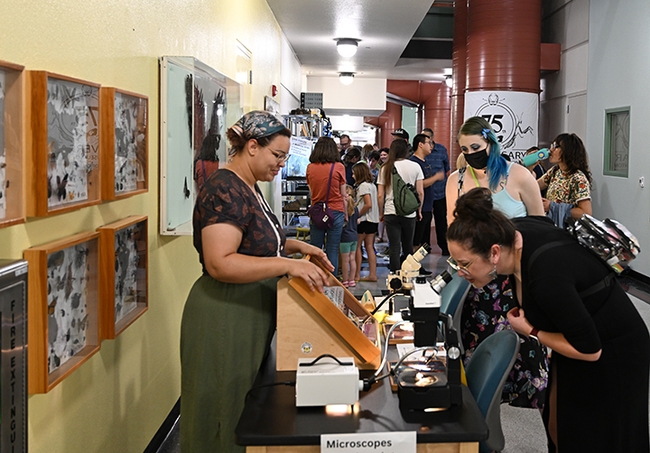
Iris Quayle of the laboratory of Jason Bond, director of the Bohart Museum, explains the differences between moths and butterflies. (Photo by Kathy Keatley Garvey)
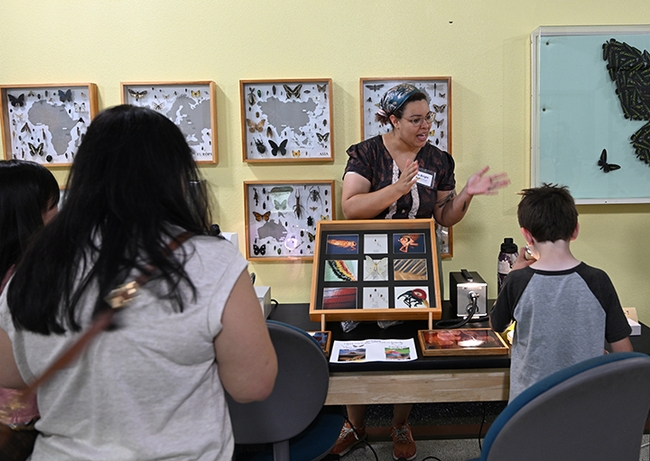
UC Davis doctoral candidate Iris Quayle answering questions from the visitors at the Bohart Museum open house. (Photo by Kathy Keatley Garvey)
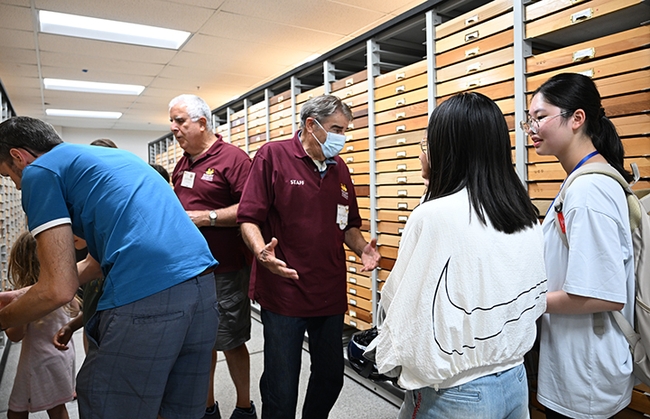
Jeff Smith (left), curator of the Lepidoptera collection at the Bohart Museum, and Bohart associate Greg Kareofelas talk to open house attendees and show moth specimens. (Photo by Kathy Keatley Garvey)
Jeff Smith: Busy as a Bee? No, As Industrious as a Lepidopterist
Busy as a bee? No, as industrious as a Lepidopterist. Specifically, as industrious and dedicated as Jeff Smith, curator of the moth and butterfly collection at the UC Davis Bohart Museum of Entomology--a collection that an international...

Jeff Smith, curator of the Bohart Museum of Entomology's Lepidoptera collection, chats with visitors at an open house. (Photo by Kathy Keatley Garvey)

Legendary Lepidopterists Paul Opler (left) and Robert Michael Pyle, founder of the Xerces Society for Invertebrate Conservation, chat during the international Lepidopterist Society’s 68th annual conference (2019) that included visits to the Bohart Museum. Opler, who died last year, considered the Bohart Museum Lepidoptera collection "The Bold Standard" of Lep collections. (Photo by Kathy Keatley Garvey)

